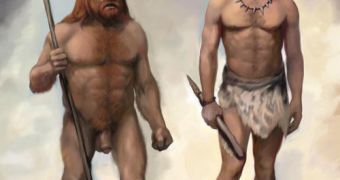Our closest evolutionary relative was the Neanderthal man (Homo neanderthalensis). But when did we share a common ancestor? A new research published in the journal "Proceedings of the National Academy of Sciences" shows that gradual changes in human skull size and shape would indicate that, 300,000 to 400,000 years ago, Neanderthals and modern humans separated their evolutionary pathways.
All previous estimates were DNA analysis based; this is the first using the speed of change of physical traits. DNA analyses use the "molecular clock," which comes with a timing of separation of the related species based on the rhythm of accumulation of mutations.
"But that is true only if the differences (read mutations) are due to the random process of "genetic drift," and not driven by natural selection," said lead author Tim Weaver of the University of California Davis.
Genetic drift refers to the accumulation of new traits (mutations) in different populations by the spread of chance mutations, which do not come with any advantage in survival or reproduction, nor do they harm. For example, such random mutations explain why people no longer have the low forehead and protruding brow like Neanderthal and other extinct or living relatives (like chimps).
"If differences in human skulls are due to genetic drift, then the amount of divergence will be proportional to the amount of time elapsed since the ancestors of Neanderthals and modern humans [separated] from each other," said Weaver.
Skull talks
The research team measured a set of 37 skull traits in modern human and Neanderthals, including the width of the jaw and eye sockets, and the distance between different cranial bones. Even amongst different human races, there are slight variations in cranial measurements. Among the races, genes vary, and so do the skulls.
DNA analysis can give us a glimpse of when present-day human races started to form. This way, the team could find the rhythm at which skull traits accumulate. This speed of transformations between the human races was observed between Homo sapiens and Neanderthals.
The new research "is valid in indicating that those aspects of the human cranium that are likely to be governed by random processes, such as drift, are in agreement with genetic analyses. Both of them are [also] in general agreement with the fossil record, which indicates that you start getting divergent aspects of human anatomy in Africa and Europe 300,000 to 500,000 years ago," said Erik Trinkaus, a Neanderthal expert at Washington University in St. Louis.
But some cranial traits are strongly ruled by selection. The large heads and brains of both species of Homo were created before the split by natural selection.
"Once these features evolved, however, the main role of natural selection on the skull has been to constrain its dimensions to a range of variation necessary to accommodate and protect the brain. Within this range, cranial form may have virtually no influence on which individuals survive and reproduce. Under these circumstances, changes in cranial form will be due to chance," said Weaver.

 14 DAY TRIAL //
14 DAY TRIAL //